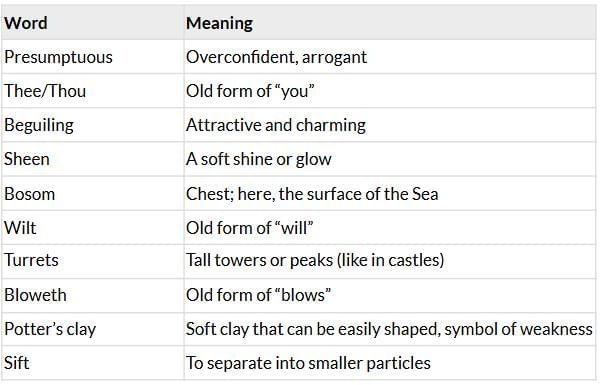Summary: The Rock and the Sea | Gul Mohar Class 8: Book Solutions, Summaries & Worksheets PDF Download
| Table of contents |

|
| About the Author |

|
| Detailed Summary |

|
| Moral / Message |

|
| Vocabulary Table |

|
About the Author
Charlotte Perkins Gilman (1860–1935) was an American writer, poet, and social reformer. She wrote novels, essays, short stories, and poems. Gilman is best remembered for her fight for women’s rights and social justice. Her famous work The Yellow Wallpaper shows her concern about women’s struggles. In this poem, she explores the never-ending contest between strength and change in nature.
Detailed Summary
Stanza 1 – The Rock
I AM the Rock, presumptuous Sea!
I am set to encounter thee.
Angry and loud, or gentle and still,
I am set here to limit thy power, and I will—
I am the Rock!
Explanation:
The Rock speaks with pride and confidence. It calls the Sea “presumptuous,” meaning overconfident. The Rock says it has been placed on Earth to face the Sea, whether the waves come in anger (stormy seas) or in gentleness (calm waters). The Rock believes its job is to stop the Sea from spreading too far, and it proudly declares that it will never move. Here, the Rock represents firmness, stability, and resistance.
Stanza 2
I am the Rock, beguiling Sea!
I know thou art fair as fair can be,
With golden glitter and silver sheen,
And bosom of blue and garments of green.
Thou mayst pat my cheek with baby hand,
And lap my feet in diamond sands,
And play before me as children play,
But plead as thou wilt, I bar the way!
I am the Rock!
Explanation:
The Rock admits that the Sea is beautiful and charming (“beguiling”). It describes the Sea’s colors—golden, silver, blue, and green. The waves may touch the Rock gently, like a child stroking a cheek, or play around it like children playing in sand. Still, the Rock declares that it will never give in to the Sea’s power or beauty. It will block the Sea no matter what. This shows the Rock’s unbending pride and determination.
Stanza 3 – The Sea
I am the Sea. I hold the land
As one holds an apple in his hand.
Hold it fast with sleepless eyes,
Watching the continents sink and rise.
Out of my bosom the mountains grow,
Back to its depths they crumble slow:
The earth is a helpless child to me—
I am the Sea!
Explanation:
Now the Sea speaks. It says it is far more powerful than the Rock. The Sea compares holding the land to holding an apple in one’s hand—effortless. The Sea watches the continents form and break apart over time. Even the mountains, which seem so strong, rise from the Sea and eventually crumble back into it. The Sea declares that the Earth itself is helpless before its endless strength. Here, the Sea represents change, time, and the unstoppable power of nature.
Stanza 4
I am the Sea. The earth I sway;
Granite to me is potter’s clay;
Under the touch of my careless waves
It rises in turrets and sinks in caves;
The iron cliffs that edge the land
I grind to pebbles and sift to sand,
And beach-grass bloweth and children play
In what were the rocks of yesterday;
It is but a moment of sport to me—
I am the Sea!
Explanation:
The Sea boasts that it can move and shape the Earth. Even the hardest granite stone is like soft clay in its hands. With its waves, the Sea forms high peaks (turrets) and deep hollows (caves). The strongest cliffs of iron and rock are slowly broken down into pebbles and then into sand. Places where children now play on beaches were once solid rocks, showing how quickly the Sea changes the land. The Sea says that all this—destruction and reshaping of Earth—is only a game or “sport” to it. This stanza shows the Sea’s endless power, patience, and ability to change everything over time.
Moral / Message
The poem presents a conversation between the Rock and the Sea, symbolizing two forces of nature: stability versus change. The Rock represents firmness, pride, and resistance, while the Sea represents power, movement, and time. The message is that no matter how strong or proud something may be, continuous change and the forces of nature will eventually overcome it. It teaches us that change is inevitable and that nothing lasts forever against time and nature’s power.
Vocabulary Table

|
32 videos|62 docs|17 tests
|
FAQs on Summary: The Rock and the Sea - Gul Mohar Class 8: Book Solutions, Summaries & Worksheets
| 1. What is the central theme of "The Rock and the Sea"? |  |
| 2. How do the characters in "The Rock and the Sea" represent different aspects of life? |  |
| 3. What moral lesson can be derived from the story "The Rock and the Sea"? |  |
| 4. What literary devices are used in "The Rock and the Sea"? |  |
| 5. How does the setting contribute to the overall message of "The Rock and the Sea"? |  |




















